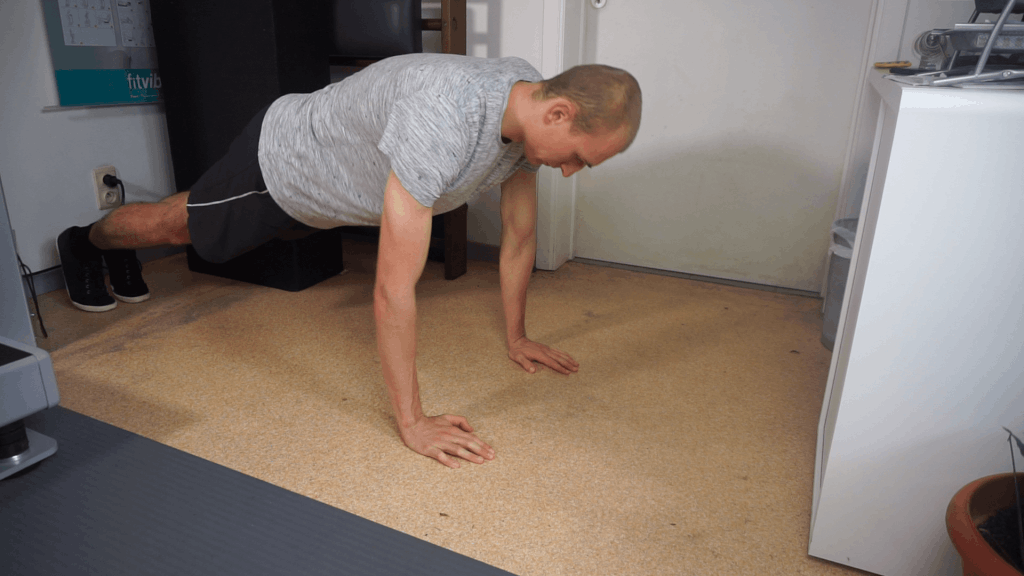Many people know about the classic plank exercise but you may wonder how to do the walking version and what it offers.
The first thing to note is that different movements get the same walking plank.
In this article, the walking plank is an exercise where you switch between the high plank and low plank position.
The main benefit of this variation over the regular plank is that you make it a bit more interesting.
Besides that, the walking plank still works your abs and hip flexors in isometric (static) ways with a bit of tricep, chest, and shoulder engagement.
This also means that more dynamic ab exercises tend to be more effective than walking planks. At least if you don’t find these too uncomfortable to do.
How to do a walking plank
Take the following steps to do a walking plank:
- Get in a high plank position. This means you stand on your hands and front feet with slightly less than stretched arms and a body that is in one line from your heels to your head.
- Shift your weight to one arm and lift the hand on the other side off the ground.
- Slowly fold the arm that is in the air and put the forearm on the ground.
- Shift your weight to the forearm that is on the ground and repeat the movement from step 3 with your other arm.
- Repeat these steps but go from leaning on your forearms to getting back in the high plank position from the beginning.

To save your elbows and wrists from pain you don’t want to move too roughly.
Doing the walking plank faster will not really make it more effective anyway.
Besides that, you want to keep in mind to keep your wrists more or less below your shoulders while in the high plank position.
Lastly, you generally want to keep your neck in one line with your upper body while doing walking planks to avoid any discomfort.
Muscles worked with walking planks
While the movement is clearly different, walking planks still mainly work your abs and hip flexors similar to the regular plank exercise.
At the same time, it is true that you engage your triceps (back upper arms), chest, and front deltoids (shoulders) slightly more.
This similar engagement means walking planks have the same “issue” as regular planks.
Isometric (static) exercises tend to be less effective for growing and strengthening muscles than more dynamic exercises.
In simpler words, more dynamic ab exercises tend to be better than walking planks for growing and strengthening muscles.
That being said, it is still possible to get these results from walking planks.
You will have to consider doing walking weighted planks and paying extra attention to your sets and reps counts.
Since they are so similar, you can check out the article on how many planks you should do to do the walking version effectively.
Walking plank benefits
Even if walking planks are not necessarily the most effective exercise, they can still offer nice benefits. Some examples are:
- Balance and coordination: You may take a while to get used to walking planks due to the balance and coordination involved. This can improve your skills in these fitness components.
- Stronger muscles: Doing walking planks enough times with enough resistance can still help you grow and strengthen your abs and hip flexors.
- Could be more comfortable: One of the benefits of static exercises like the walking plank is that they can be more comfortable on your spine than dynamic alternatives.
- Makes things more interesting: The regular plank is not quite the most exciting exercise out there. Doing the walking variation makes things at least a bit more interesting.
- May reduce or prevent back pain: Improving ab muscle endurance and potentially size with the walking plank can help reduce and avoid back pain (1, 2).
These benefits of walking planks may not be unique but if you like the movement, you can consider adding it to your exercise routine.
Walking plank alternatives
You could also want to know what exercises are more effective, work different muscles, or train similar things in a different way.
If these things apply to you, you can also consider these walking plank alternatives:
- Crunches
- Ab wheel roll-outs
- Plank toe touches
- Pushups
- Bicycle crunches
- Hanging leg raises
- Heel taps
- Sit-ups
What the best walking plank alternatives are for your situation depends on details like what you want to train and what your body can deal with.
Are walking planks a good exercise?
Walking planks can be a good exercise for people who find more dynamic ab exercises too uncomfortable and regular planks too boring.
At the same time, you want to know that these more dynamic ab exercises tend to be more effective than walking planks for growing and strengthening your abs.
For both of these options, you also want to keep in mind that you still need to do enough repetitions with enough resistance for whatever goal you are trying to achieve.
Additionally, it is worth noting that enjoying the exercises you do is a valuable thing too.
You could still consider doing walking planks if you really like doing them more than the available alternatives.
This enjoyment can make it easier to stay consistent which is very important for getting in shape (and staying there).
